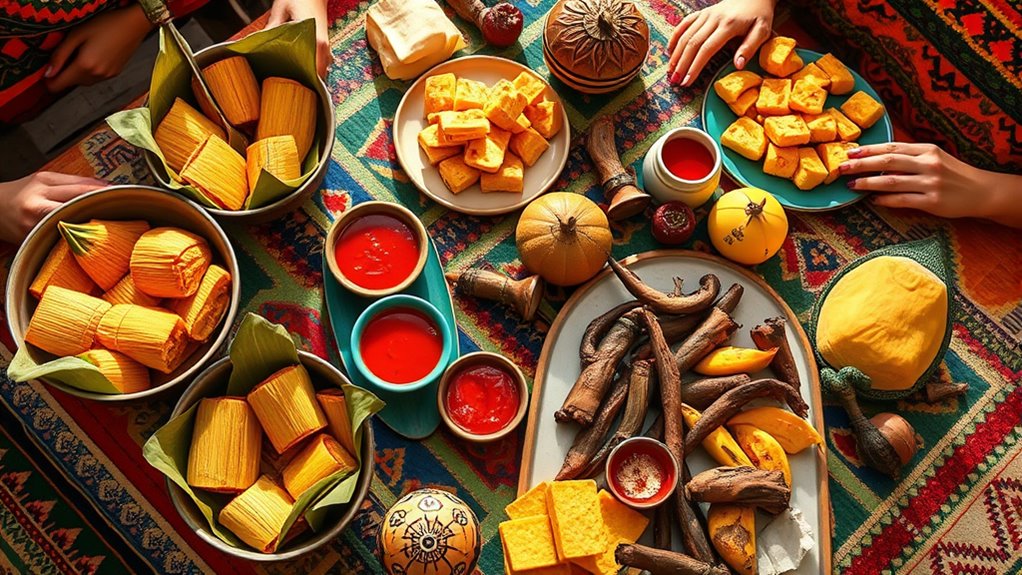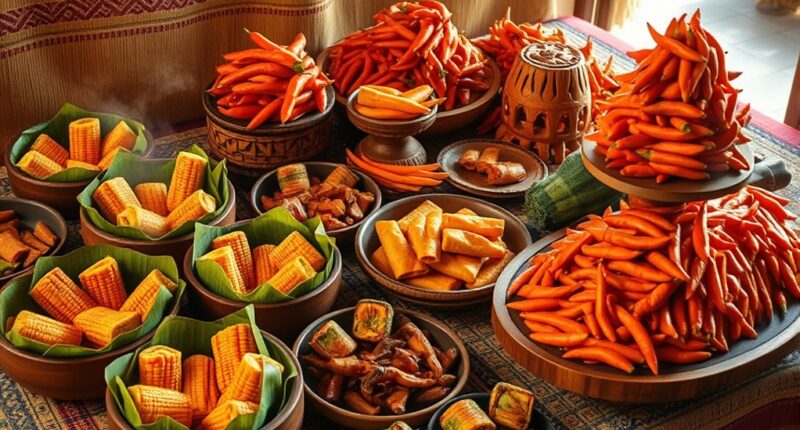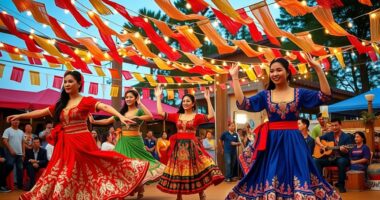During celebrations and ceremonies, indigenous dishes act as powerful symbols of cultural pride, spiritual connection, and community resilience. You’ll find traditional foods like bread, rice, or sweet treats that represent abundance, health, or joy. These foods often follow specific rituals and preparation methods that honor ancestors and cultural values. By understanding these festive foods, you deepen your appreciation for cultural heritage. Exploring more reveals how such dishes preserve history and strengthen collective identity.
Key Takeaways
- Indigenous dishes often symbolize prosperity, health, and spiritual blessings during festivals and ceremonies.
- Traditional recipes involve specific rituals and techniques that honor ancestors and cultural beliefs.
- Foods serve as edible stories, connecting communities to their history, migrations, and spiritual practices.
- Celebratory indigenous foods reinforce cultural pride, resilience, and shared identity across generations.
- Preparing and sharing these dishes promotes cultural continuity and deepens appreciation for heritage.

Have you ever wondered why certain foods become staples during festive seasons? It’s often because these dishes carry food symbolism that connects communities and individuals to their heritage, beliefs, and shared history. These foods aren’t chosen at random; they’re deeply rooted in culinary traditions that have been passed down through generations. When you partake in these traditional dishes, you’re participating in a cultural dialogue that celebrates identity, resilience, and unity. Food symbolism plays a crucial role in these celebrations, transforming simple ingredients into powerful symbols of prosperity, health, and spiritual significance. For example, in many cultures, bread or rice represents abundance and sustenance, while sweet treats symbolize joy and prosperity. These symbols elevate ordinary foods into meaningful expressions of collective hopes and values, making them central to festive gatherings.
Food symbolism connects traditions to heritage, transforming dishes into powerful symbols of prosperity, health, and shared identity.
Culinary traditions shape the way communities prepare and present these dishes, often adhering to specific methods and rituals that honor ancestors and cultural history. You might notice that during holidays, certain recipes are prepared in a particular way, often with ceremonial significance attached. These traditions reinforce bonds among family members and community groups, creating a sense of continuity amid change. For instance, in some indigenous celebrations, specific herbs, spices, or cooking techniques are used to invoke spiritual blessings or to honor deities. The way these foods are cooked, served, and consumed is as important as the ingredients themselves, emphasizing respect for cultural practices and history.
During celebrations, indigenous dishes often tell stories—about origins, migrations, or spiritual beliefs—making them more than just sustenance. They become edible history lessons that connect you to your roots. When you sit down to enjoy these foods, you’re not only nourishing your body but also affirming your cultural identity and honoring your ancestors’ wisdom. The preparation of these dishes can be a communal activity, fostering a sense of belonging and shared purpose. It’s a way to preserve cultural memory in the face of modernity, ensuring that culinary traditions remain alive and meaningful for future generations.
In essence, the foods served during festive seasons are much more than just delicious; they’re symbols infused with cultural significance, representing collective resilience and identity. By understanding the food symbolism behind these indigenous dishes, you gain a deeper appreciation for the traditions that shape and sustain communities. Celebrating with these foods allows you to partake in a rich tapestry of history, spirituality, and cultural pride, making every bite a meaningful connection to the past and a hopeful step into the future.
Frequently Asked Questions
How Do Traditional Recipes Vary Across Different Indigenous Communities?
You’ll notice that traditional recipes vary across indigenous communities due to local ingredient variations and cooking technique differences. For example, some communities use specific native plants or meats, shaping the flavor profiles uniquely. Additionally, cooking methods like open-fire grilling or steaming reflect cultural practices and available resources. These variations make each community’s festive foods distinct, celebrating their environment and traditions through unique culinary expressions.
What Are the Symbolic Meanings Behind Specific Festive Dishes?
You’ll find that specific festive dishes hold deep symbolic significance and ritual meanings. For example, certain foods represent fertility, prosperity, or community unity, serving as blessings for the coming year. Preparing and sharing these dishes during celebrations reinforces cultural identity and spiritual beliefs. By understanding their symbolic significance, you connect more meaningfully with traditions, recognizing how each ingredient and preparation method embodies values passed down through generations.
How Are Indigenous Ingredients Preserved and Passed Down Through Generations?
Like treasured heirlooms, indigenous ingredients are carefully preserved through stories, rituals, and hands-on teaching. You pass down knowledge of traditional harvesting and cooking methods, ensuring cultural preservation remains vibrant. By practicing culinary authenticity, you keep ancient flavors alive and honor your ancestors. Sharing these recipes with younger generations is like planting seeds for future generations to nurture, ensuring that indigenous ingredients continue to thrive and tell their stories through time.
What Role Do Festive Foods Play in Indigenous Spiritual Practices?
Festive foods hold deep ritual significance in indigenous spiritual practices, serving as essential ceremonial offerings that honor spirits and ancestors. You participate in these traditions by preparing specific dishes that symbolize respect and connection to nature. These foods often mark important events, reinforcing cultural identity and spiritual beliefs. By engaging in these culinary rituals, you help preserve sacred customs and maintain a spiritual bond across generations.
How Has Modernization Impacted Indigenous Culinary Traditions During Celebrations?
Modernization has substantially impacted indigenous culinary traditions during celebrations by promoting cultural assimilation and culinary adaptation. You might notice traditional recipes being altered to include more accessible ingredients or influenced by mainstream cuisine. This shift can lead to the loss of authentic flavors and cultural significance, but it also offers opportunities to innovate and keep traditions alive in new ways. Embracing these changes helps preserve your heritage while adapting to a modern world.
Conclusion
As you savor these indigenous dishes during celebrations, remember they carry stories and secrets waiting to be uncovered. Each bite connects you to centuries of tradition, yet there’s always more to discover beneath the surface. What other hidden flavors and rituals lie ahead, waiting to be explored in these festive foods? The journey into their rich cultural tapestry is far from over—you’ll find that every celebration invites a new adventure, and the most intriguing secrets are yet to come.









